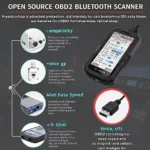Understanding OBD2 codes is crucial for any car owner or mechanic. These codes, generated by your vehicle’s onboard diagnostic system, act as a window into the inner workings of your car, providing valuable insights into potential issues. By learning to decipher these codes, you can save time and money on repairs, and even prevent costly breakdowns down the road.
What are OBD2 Codes?
OBD2, or On-Board Diagnostics, is a standardized system used in vehicles to monitor and report on the performance of various engine and emissions-related components. When a problem is detected, the system generates a specific alphanumeric code, known as an OBD2 code. These codes are essential for diagnosing and troubleshooting vehicle problems. For example, understanding OBD2 codes like those discussed on pages addressing specific issues like obd2 codes 2110 can be incredibly helpful. Each code corresponds to a specific malfunction, pointing mechanics in the right direction for repairs.
Think of OBD2 codes as your car’s way of communicating with you. Instead of vague symptoms, you get precise information about what’s going wrong. This allows for faster and more accurate diagnoses, preventing unnecessary guesswork and potentially saving you money. Having a good understanding of these codes empowers you to take control of your car’s maintenance.
Decoding the Structure of OBD2 Codes
Understanding OBD2 codes starts with understanding their structure. Each code follows a specific format: a letter followed by four numbers. The letter indicates the system where the fault is detected, while the numbers pinpoint the specific problem within that system. For instance, a “P” code refers to the powertrain, a “B” code relates to the body, a “C” code to the chassis, and a “U” code to the network communication systems. Learning this structure is the first step towards effectively using these codes. Resources like those detailing obd2 codes chrysler can provide valuable insights into manufacturer-specific codes.
How to Read an OBD2 Code
- First Letter (System): Identifies the system related to the fault (P, B, C, U).
- First Digit (Generic or Manufacturer-Specific): A “0” indicates a generic code, applicable across most vehicle makes. A “1” denotes a manufacturer-specific code.
- Second Digit (Subsystem): Further narrows down the area within the system (e.g., fuel and air metering, ignition system).
- Third and Fourth Digits (Specific Fault): Pinpoint the exact nature of the malfunction within the subsystem.
Common OBD2 Codes and Their Meanings
While there are thousands of potential OBD2 codes, some appear more frequently than others. Familiarizing yourself with these common codes can be particularly helpful. Understanding these codes can also help you interpret information on sites like obd2 codes p0420 p0172 which address specific code combinations.
- P0420: Catalyst System Efficiency Below Threshold (Bank 1) – This often indicates a failing catalytic converter.
- P0171: System Too Lean (Bank 1) – This suggests a problem with the fuel system, possibly a vacuum leak or faulty fuel injector.
- P0300: Random/Multiple Cylinder Misfire Detected – This points to issues with the ignition system, fuel delivery, or even mechanical problems within the engine.
“Understanding the meaning behind common OBD2 codes can save car owners a significant amount of time and stress,” says John Smith, Senior Automotive Diagnostic Technician at Acme Auto Repair. “It allows them to communicate more effectively with mechanics and make informed decisions about repairs.”
Using an OBD2 Scanner to Retrieve Codes
Retrieving OBD2 codes requires an OBD2 scanner, a readily available and relatively inexpensive tool. Simply plug the scanner into your car’s diagnostic port (usually located under the dashboard) and follow the scanner’s instructions to retrieve the codes. Sites like obd2 p0441 p0442 p0446 can be helpful for understanding specific code groups related to evaporative emission systems. Being able to access these codes yourself empowers you with valuable information before even visiting a mechanic.
 OBD2 Scanner Connected to Car
OBD2 Scanner Connected to Car
Conclusion: Empowering Yourself with OBD2 Knowledge
Understanding OBD2 codes is an invaluable skill for any car owner. By learning to interpret these codes, you gain a deeper understanding of your vehicle’s health, empowering you to make informed decisions about maintenance and repairs. This knowledge can save you time, money, and prevent potential headaches down the road. Understanding OBD2 codes is like having a direct line of communication with your car, giving you the insights you need to keep it running smoothly. Resources like the obd2 codes 2006 ma'sda page can be beneficial for those looking for model-specific information.
FAQ
-
What does OBD2 stand for?
OBD2 stands for On-Board Diagnostics, version 2. -
Where is the OBD2 port located?
The OBD2 port is typically located under the dashboard, near the steering column. -
Do all cars have OBD2?
Most cars manufactured after 1996 in the US and after 2001 in Europe have OBD2. -
Can I clear OBD2 codes myself?
Yes, you can clear codes using an OBD2 scanner, but clearing them doesn’t fix the underlying problem. -
Are all OBD2 codes the same?
No, codes vary depending on the vehicle manufacturer and the specific problem. -
What should I do if my check engine light stays on after clearing codes?
If the check engine light stays on, it means the underlying problem persists, and you should consult a mechanic. -
How much does an OBD2 scanner cost?
OBD2 scanners range in price from around $20 to over $100.
Need further assistance? Please don’t hesitate to contact us via WhatsApp: +1(641)206-8880, Email: [email protected], or visit us at 789 Elm Street, San Francisco, CA 94102, USA. We offer 24/7 customer support. You can also find more helpful articles and information on our website, OBDFree.com, including resources on specific code combinations and vehicle models. We are here to help you navigate the world of OBD2 codes and keep your car running smoothly.

